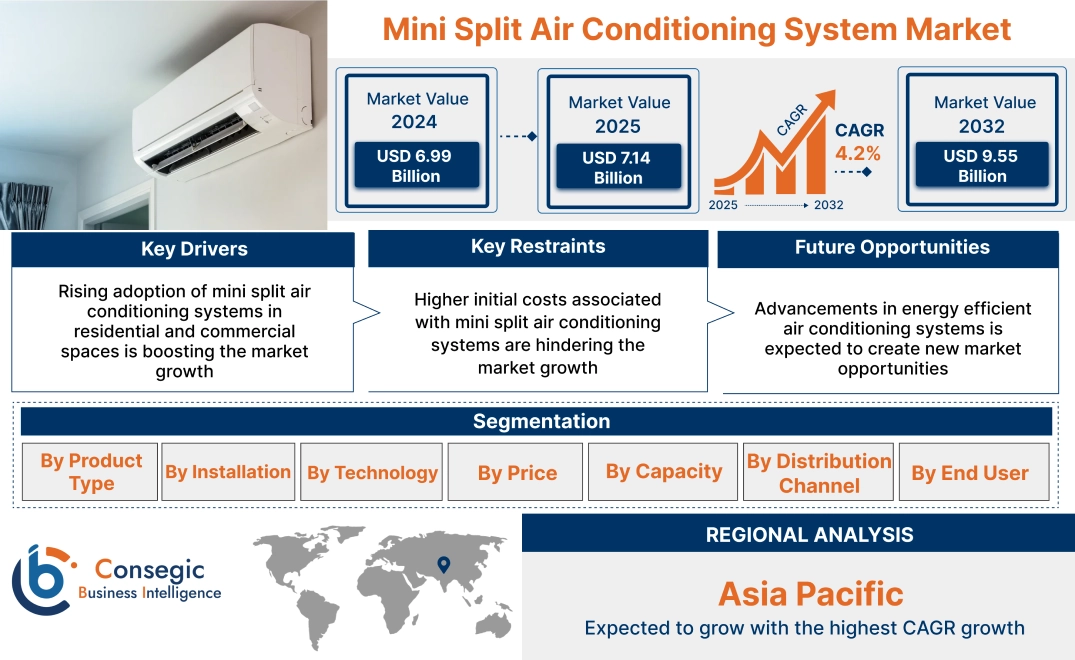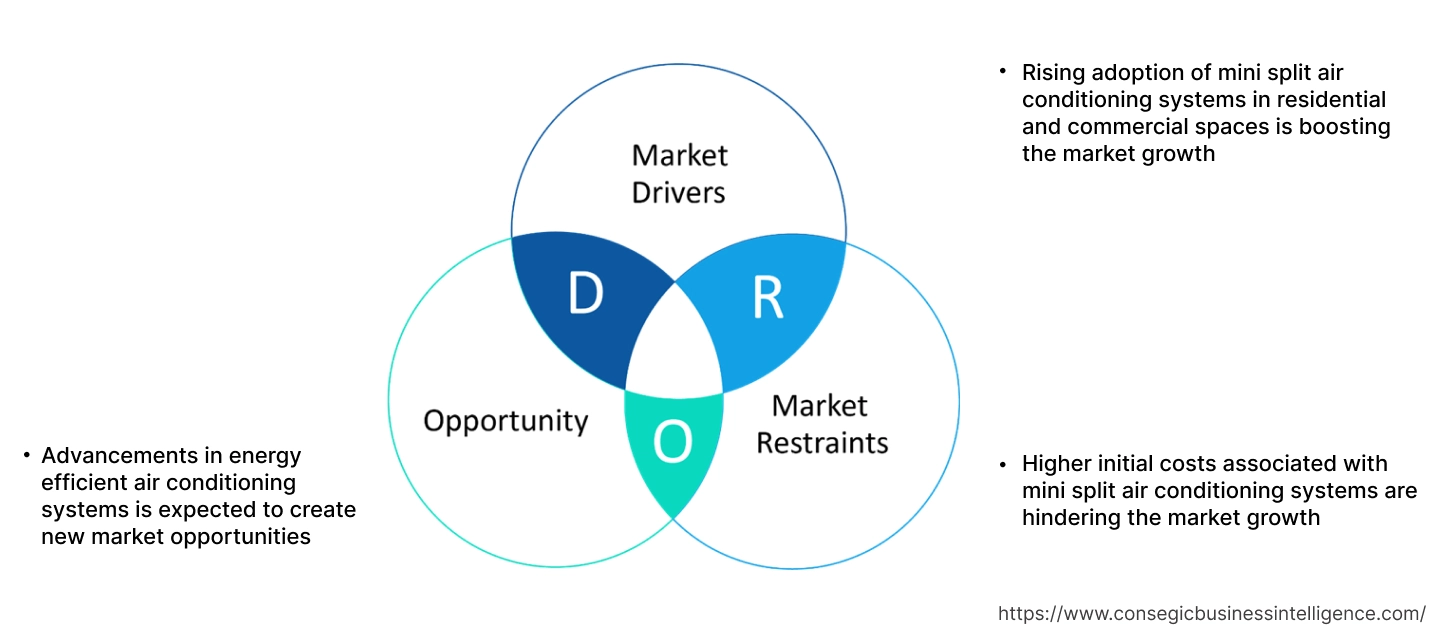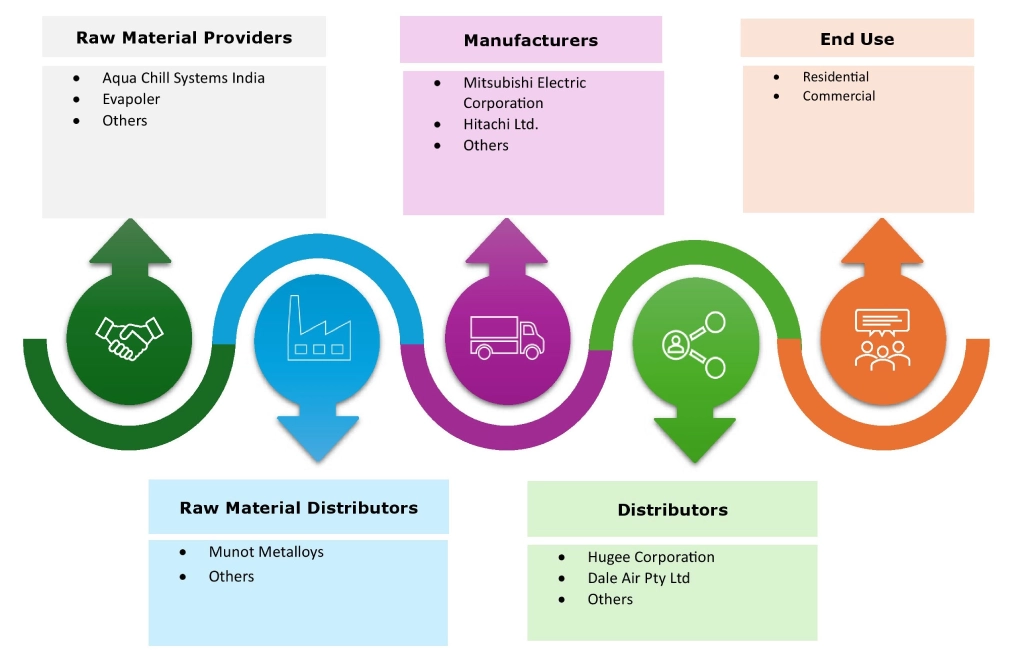- Summary
- Table Of Content
- Methodology
Mini Split Air Conditioning System Market Size:
Mini Split Air Conditioning System Market size is estimated to reach over USD 9.55 Billion by 2032 from a value of USD 6.99 Billion in 2024 and is projected to grow by USD 7.14 Billion in 2025, growing at a CAGR of 4.2% from 2025 to 2032.
Mini Split Air Conditioning System Market Scope & Overview:
Mini-split air conditioning systems or ductless systems are used for heating and cooling, particularly in homes where traditional ductwork is not feasible. They function by utilizing multiple indoor units connected to a single outdoor condenser unit through refrigerant lines. Each indoor unit can be set to a different temperature, allowing for zone control and personalized comfort. Mini-splits efficiently remove heat from a room and transfer it outside, providing cool air through the indoor units. Some mini-split systems also function as heat pumps, reversing the process to transfer heat from the outside into the room. Each indoor unit is controlled individually, allowing for precise temperature adjustments in different areas of the home. Moreover, many mini-splits include air filters that capture dust, allergens, and other particles, improving indoor air quality.
Key Drivers:
Rising adoption of mini split air conditioning systems in residential and commercial spaces is boosting the market growth
Ductless systems offer several benefits that are responsible for their adoption in residential and commercial spaces. They are more energy-efficient than central air systems because they avoid energy loss through ductwork and are zoned for individual comfort. They have the ability to be installed anywhere, even in homes without existing ductwork. Mini-splits are generally quieter than traditional air conditioning systems, particularly the indoor units. They offer air filtration and can help reduce indoor pollutants.
- For instance, according to the S. Energy Information Administration, nearly 88% of US households used air conditioning in 2020, among which two-thirds use central AC and one-thirds use any conditioning systems.
Thus, the aforementioned factors are boosting the demand for air conditioning systems, in turn driving the mini split air conditioning system market growth.
Key Restraints:
Higher initial costs associated with mini split air conditioning systems are hindering the market growth
Mini-split air conditioning systems generally have higher initial costs as compared to traditional window units or central AC systems, primarily due to the need for professional installation and the separate indoor and outdoor units. Mini-split systems require a skilled technician to install both indoor and outdoor units, and to run the refrigerant lines.
Moreover, each indoor unit controls the temperature in a specific room, so larger homes or those with zoned heating or cooling require multiple indoor units, increasing the upfront cost. Thus, the market analysis shows that the aforementioned factors are restraining the mini split air conditioning system market demand.
Future Opportunities :
Advancements in energy efficient air conditioning systems is expected to create new market opportunities
Mini-splits allow for independent temperature control in different rooms or zones, preventing wasted energy in unoccupied spaces. Advanced models feature high SEER (seasonal energy efficiency ratio) and COP (coefficient of performance) ratings, indicating their ability to provide more cooling output for less energy input. Many mini-splits use inverter technology, which adjusts the compressor speed to match the cooling demand, further optimizing energy use. Compared to older air conditioning systems, mini-splits significantly reduce energy consumption and electricity bills.
- For instance, International Energy Agency (IEA) states that effective policies will be able to double average AC efficiency and reduce cooling energy demand by 45%.
Thus, the ongoing advancements in air conditioning systems are projected to drive mini split air conditioning system market opportunities during the forecast period.
Mini Split Air Conditioning System Market Segmental Analysis :
By Product Type:
Based on the product type, the market is segmented into single-zone mini-splits and multi-zone mini-splits.
Trends in the Product Type:
- Rising demand in single-zone mini-splits due to benefits including easy installation and high energy efficiency.
- Increasing trend in adoption of multi-zone mini-splits for larger areas including homes, offices, and others.
The single-zone mini-splits segment accounted for the largest revenue share in the market in 2024.
- A ductless AC with a single zone system consists of one outdoor unit and one indoor unit, providing temperature control for a single room or area.
- These systems are ideal for spaces lacking central ductwork, such as bedrooms, garages, or additions.
- For instance, in August 2024, Mini Split launched Bravo Single Zone Mini Splits product lineup. The systems are designed to accommodate spaces from 600 to 1800 square feet. The systems have a capacity of 2-ton, and delivers up to 24,000 British Thermal Unit (BTU) per hour of power.
- Therefore, the wide spread adoption of single-zone mini-splits for residential applications is boosting the mini split air conditioning system market growth.
The multi-zone mini-splits segment is expected to register the fastest CAGR during the forecast period.
- Ductless multi-zone AC systems offer individual temperature control in different areas of a home or building, allowing for customized comfort and energy efficiency.
- They achieve this by connecting multiple indoor units to a single outdoor unit, enabling independent temperature settings for each zone. This system is particularly useful in larger homes, older homes without ductwork, or buildings with varying heating and cooling needs.
- Moreover, multi-zone systems are integrated with advanced filtration systems, reducing dust, allergens, and other particulates. The compact and sleek design of the units enables flexible installation without taking up much space.
- Thus, the rising adoption of multi-zone mini-splits in commercial sector is projected to boost the mini split air conditioning system market trends during the forecast period.
By Installation:
Based on the installation, the market is segmented into wall mounted, floor-standing, and others.
Trends in the Installation:
- Rising demand for floor standing air conditioners that allows easy maintenance and less operating expenses.
- Increasing adoption of floor ceiling air conditioners for easy installation, energy efficiency, and flexible zoning capabilities.
The wall mounted segment accounted for the largest revenue share of 59.88% in the market in 2024 and it is expected to register the fastest CAGR during the forecast period.
- Wall-mounted ductless air conditioners offer numerous benefits over traditional window units and central AC systems. They are more energy-efficient, quieter, and have better indoor air quality, while also being easier to install and less visually intrusive.
- For instance, in March 2024, Mitsubishi Electric Trane HVAC US LLC introduced the premier wall-mounted indoor units. The systems include both single and multi-zone hyper-heating inverter units and are compatible with single-zone and multi-zone heat pump outdoor units.
- Thus, the mini split air conditioning system market analysis depicts that the aforementioned factors are expected to drive the market during the forecast period.
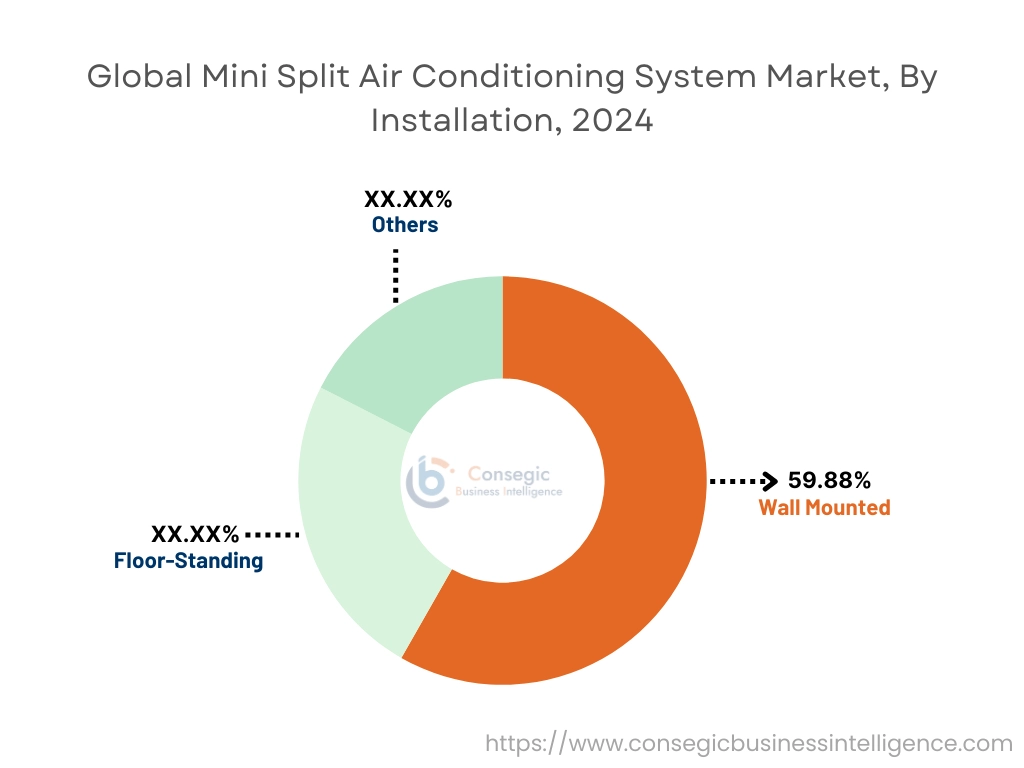
By Technology:
Based on the technology, the market is segmented into inverter mini-splits and non-inverter mini-splits.
Trends in the Technology:
- Rising adoption of inverter mini-splits for flexibility and energy efficiency is boosting the market growth.
- Increasing adoption of non-inverter mini-splits to provide short-term cooling needs in a budget friendly option.
The inverter mini-splits segment accounted for the largest revenue in the mini split air conditioning system market share in 2024.
- Ductless AC units with inverter technology offer several benefits, including enhanced energy efficiency, personalized comfort, and quieter operation. They are also easier to install than traditional ducted systems and can save space.
- Inverter technology allows variable compressor speeds, leading to better temperature control and potentially lower energy bills.
- For instance, Hitachi offers inverter split air conditioners in its product portfolio. The products are available in various models including Yoshi lineup, Izen lineup, and Yoshi lineup.
- Therefore, the aforementioned factors are driving the mini split air conditioning system market size.
The non-inverter mini-splits segment is expected to register the fastest CAGR during the forecast period.
- Ductless AC units, particularly when paired with a non-inverter compressor, offer benefits such as easy installation, flexibility in placement, and zoning capabilities.
- Non-inverter models are generally more affordable, making them a budget-friendly option, specifically for those with occasional or short-duration cooling needs.
- For instance, Daikin Airconditioning India Pvt. Ltd. offers non-inverter mini-splits in its product offering. The products are available in various models including FTL30, FTL28U, FTL35U, FTL50U, FTQ50U, and others.
- Thus, the rising adoption of non-inverter mini-splits is expected to boost the mini split air conditioning system market trends during the forecast period.
By Price:
Based on the price, the market is segmented into low, medium, and high.
Trends in the Price:
- Rising demand for low priced air conditioning systems to provide temporary cooling or heating solutions is boosting the market growth.
- Increasing adoption of high priced conditioning systems for advanced features, improved performance, and enhanced energy efficiency.
The low segment accounted for the largest revenue in the mini split air conditioning system market share in 2024.
- The low-priced air conditioning systems are primarily adopted by residential and smaller commercial spaces.
- These systems enable heating or cooling solutions with minimal extra features and with lower initial and operational costs.
- These systems are mostly suited for indoor locations, with less space, leading to efficient cooling.
- Therefore, the aforementioned factors are driving the mini split air conditioning system market size.
The high segment is expected to register the fastest CAGR during the forecast period.
- The high-priced air conditioning systems are adopted in large commercial spaces including large offices, airports, shopping malls, and others.
- These systems require high initial and operational costs, and also provide more advanced features including energy-efficiency, smart controls, and others.
- Moreover, these systems also include features including mobile app control, scheduling, and energy monitoring.
- Thus, the mini split air conditioning system market analysis depicts that the aforementioned factors are expected to boost the market growth during the forecast period.
By Capacity:
Based on the capacity, the market is segmented into less than 1 ton, 1 to 1.5 ton, 1.5 to 2 ton, and more than 2 ton.
Trends in the Capacity:
- Rising adoption of 1 ton air conditioning systems for smaller spaces that requires limited heating or cooling capacity.
- Increasing adoption of 1 to 1.5 ton air conditioning systems to provide heating and cooling solutions for medium to large spaces including offices, apartments, and others.
The 1 to 1.5 ton segment accounted for the largest revenue share in the market in 2024.
- A 1 to 1.5-ton air conditioner typically has a cooling capacity of 12,000 to 18,000 BTU per hour. This indicates the amount of heat energy that the system is able to remove from the space within one hour.
- For instance, Voltas offers various 1 to 1.5 ton air conditioning systems in its product portfolio. The systems are available in multiple variants including adjustable inverter, adjustable inverter window, all weather heavy duty inverter, smart air inverter, split, Voltas pure air inverter, and window.
- Therefore, the widespread adoption of 1 to 1.5 ton air conditioning systems in residential areas and small spaces is boosting the market growth.
The 2 ton segment is expected to register the fastest CAGR during the forecast period.
- A 2-ton mini split system has a cooling capacity of 24,000 BTU per hour. These systems provides sufficient cooling capacity for medium to large rooms, which ensures efficient temperature control and comfort.
- For instance, Hitachi offers 2 ton air conditioning systems in its product portfolio. The products are available in Yoshi 5400FXL, Izen 3400FXL, IZen 3400SXL, IZen 3400SXL, and Yoshi 5500STXL models.
- Thus, the rising demand for 2 ton air conditioning systems in commercial and larger spaces is expected to boost the mini split air conditioning system market opportunities during the forecast period.
By Distribution Channel:
Based on the distribution channel, the market is segmented into online and offline.
Trends in the Distribution Channel:
- Rising adoption of online channels due to wide options availability, offers, and personalized product shortlisting.
- Increasing adoption of offline channels for immediate availability of the product is driving the market.
The offline segment accounted for the largest revenue share in the market in 2024.
- Offline sales channels offer unique advantages in building strong customer relationships and providing immediate access to products.
- Moreover, offline sales channels enable personalized interactions, making them valuable for certain products and customer segments.
- Customers are able to physically see, touch, and even try out products that significantly impact their purchasing decisions and create a more engaging shopping experience.
- Therefore, the aforementioned factors are driving the mini split air conditioning system market expansion.
The online segment is expected to register the fastest CAGR during the forecast period.
- The online sales channel offers benefits including expanded reach, cost-effectiveness, and 24/7 availability.
- Moreover, online channels facilitate personalized shopping experiences through targeted advertising, product recommendations, and personalized content.
- Online platforms often offer simple and easy-to-use checkout processes, making it easier for customers to complete purchases.
- Thus, the market analysis depicts that the aforementioned factors are expected to boost the mini split air conditioning system market demand during the forecast period.
By End User:
Based on the end user, the market is segmented into residential and commercial.
Trends in the End User:
- Rising demand for air conditioners in residential sector due to rising temperature fluctuations is driving the market.
- Increasing adoption of air conditioners in commercial sectors for flexible and energy-efficient solution is boosting the market.
The residential segment accounted for the largest revenue share in the market in 2024.
- Mini-split air conditioners are a versatile and energy-efficient option for residential cooling, offering zoned control, easy installation, and quiet operation, making them suitable for various homes and situations.
- For instance, in January 2025, Panasonic launched a business for the OASYS Residential Central Air Conditioning System. The system is integrated with energy recovery ventilator that reduces energy consumption for air conditioning and heating by 50% as compared to conventional systems
- Therefore, the rising adoption of conditioning systems is boosting the mini split air conditioning system market expansion.
The commercial segment is expected to register the fastest CAGR during the forecast period.
- Mini-split air conditioners are installed without extensive ductwork, reducing energy loss and making them suitable for a variety of commercial spaces.
- They also allow precise temperature control in different zones, which lead to reduced energy consumption and improved comfort.
- For instance, Hitachi offers commercial air conditioning systems in its product offerings. The models available are P300 primary single-zone mini-splits systems.
- Thus, the market analysis depicts that the rising demand for air conditioning systems in commercial sector is expected to boost the market trends during the forecast period.
Regional Analysis:
The regions covered are North America, Europe, Asia Pacific, the Middle East and Africa, and Latin America.

Asia Pacific region was valued at USD 1.78 Billion in 2024. Moreover, it is projected to grow by USD 1.82 Billion in 2025 and reach over USD 2.54 Billion by 2032. Out of this, China accounted for the maximum revenue share of 28.04%. The market analysis depicts that the rising disposable income along with the rising global temperature is leading to adoption of air conditioning systems in the region.
- For instance, Panasonic Corporation, a Japan based company, offers energy efficient multi-split air conditioning systems. The products are available in 0.9 to 2.2 ton that are suitable for small to large room size. Thus, the aforementioned factors are boosting the market growth.
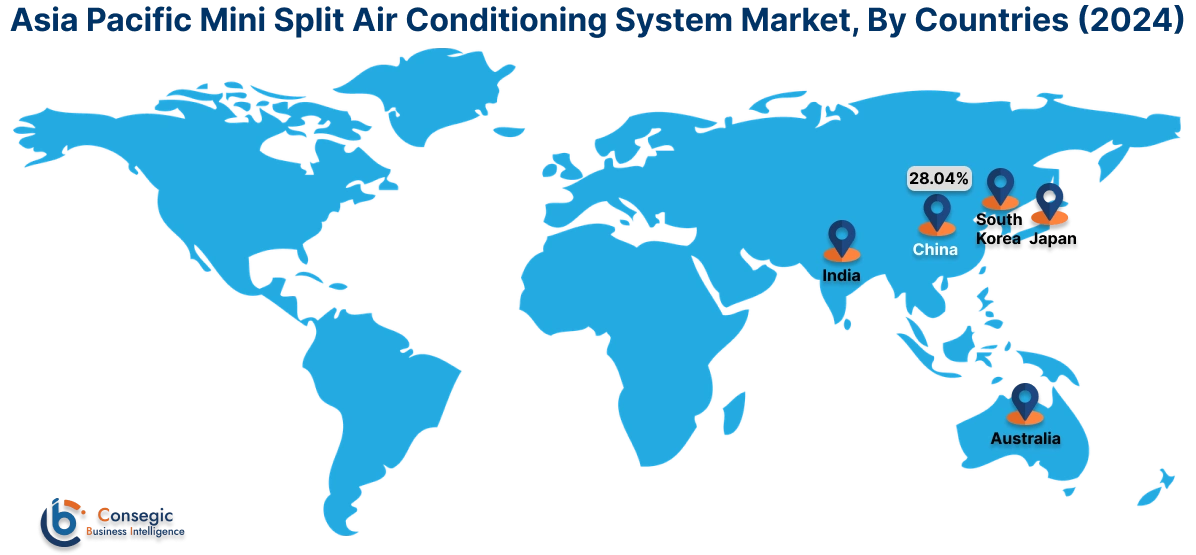
North America is estimated to reach over USD 3.46 Billion by 2032 from a value of USD 2.54 Billion in 2024 and is projected to grow by USD 2.60 Billion in 2025. The wide spread adoption of air conditioning systems in the region for residential usage is boosting the market growth. Moreover, there is a rising demand for air conditioning systems in commercial spaces includes shopping malls, offices, and others, which is further driving the market in North America.
- For instance, Carrier Corporation, a U.S based company, offers mini split air conditioning systems and heat pumps. The systems are available in various lineups including infinity, performance, comfort, and others.
In Europe, the market in the region is growing due to rising awareness among governments and consumers in prioritizing energy savings, which is further driving the adoption of mini-splits. In Latin America, Middle East and Africa, the market demand is driven by the factors including increasing disposable incomes, rising climate variability, increasing urbanization, and rising energy costs among others.
Top Key Players and Market Share Insights:
The mini split air conditioning system industry is highly competitive with major players providing products to the national and international markets. Key players are adopting several strategies in research and development (R&D), product innovation, and end-user launches to hold a strong position in the global mini split air conditioning system market. Key players in the mini split air conditioning system industry include-
- Carrier Corporation (US)
- Daikin Industries, Ltd. (Japan)
- Mitsubishi Electric Corporation (Japan)
- Panasonic Corporation (Japan)
- Samsung Electronics Co., Ltd. (South Korea)
- Senville (US)
- Toshiba Corporation (Japan)
- Trane Technologies (Ireland)
- Fujitsu General Ltd. (Japan)
- GREE Electric Appliances Inc. (China)
- Haier Group Corporation (China)
- Hitachi, Ltd. (Japan)
- Johnson Controls International plc. (Ireland)
- LG Electronics Inc. (South Korea)
- Midea Group Co., Ltd (China)
Recent Industry Developments :
Product Launches:
- In February 2025, Lennox introduced mini-split and VRF product lineups. The mini-split product line offers low global warming potential (GWP) refrigerant, ensuring an environmentally friendly solution without compromising reliable performance.
Mini Split Air Conditioning System Market Report Insights :
| Report Attributes | Report Details |
| Study Timeline | 2019-2032 |
| Market Size in 2032 | USD 9.55 Billion |
| CAGR (2025-2032) | 4.2% |
| By Product Type |
|
| By Installation |
|
| By Technology |
|
| By Price |
|
| By Capacity |
|
| By Distribution Channel |
|
| By End User |
|
| By Region |
|
| Key Players |
|
| North America | U.S. Canada Mexico |
| Europe | U.K. Germany France Spain Italy Russia Benelux Rest of Europe |
| APAC | China South Korea Japan India Australia ASEAN Rest of Asia-Pacific |
| Middle East and Africa | GCC Turkey South Africa Rest of MEA |
| LATAM | Brazil Argentina Chile Rest of LATAM |
| Report Coverage |
|
Key Questions Answered in the Report
How big is the mini split air conditioning system market? +
Mini Split Air Conditioning System Market size is estimated to reach over USD 9.55 Billion by 2032 from a value of USD 6.99 Billion in 2024 and is projected to grow by USD 7.14 Billion in 2025, growing at a CAGR of 4.2% from 2025 to 2032.
What are the major segments covered in the mini split air conditioning system market report? +
The segments covered in the report are product type, installation, technology, price, capacity, distribution channel, end user, and region.
Which region holds the largest revenue share in 2024 in the mini split air conditioning system market? +
North America holds the largest revenue share in the mini split air conditioning system market in 2024.
Who are the major key players in the mini split air conditioning system market? +
The major key players in the market are Carrier Corporation (US), Daikin Industries, Ltd. (Japan), Fujitsu General Ltd. (Japan), GREE Electric Appliances Inc. (China), Haier Group Corporation (China), Hitachi, Ltd. (Japan), Johnson Controls International plc. (Ireland), LG Electronics Inc. (South Korea), Midea Group Co., Ltd (China), Mitsubishi Electric Corporation (Japan), Panasonic Corporation (Japan), Samsung Electronics Co., Ltd. (South Korea), Senville (US), Toshiba Corporation (Japan), Trane Technologies (Ireland), and others.
